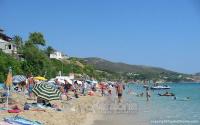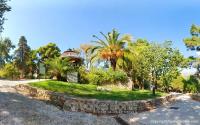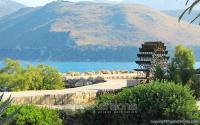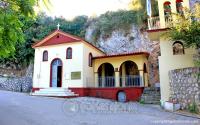Kefalonia Tour
Duration: 8 Hours
Route: Katavothres – Lighthouse of Saint Theodore – Italian Monument – Lassi – Lakithra – Kourkoumelata – Mazarakata Tombs – St. Andreas Monastery – St. Georges Castle – Robola Wine Cooperative – St. Gerasimos Monastery – Drogarati Cave – Antisamos Beach – Melissani CaveLake – Myrtos Beach – Assos – Fiscardo
The route, of approximately eight hours duration, starts from Katavothres (the sinks) where seawater enters cracks near the shore and disappears following an underground route across the whole island. Then moving towards the Lighthouse of Saint Theodore where two centuries ago, helped ships approaching the shore, to avoid the rocks.
Your tour continues at the monument of the Italians over the pine-tree covered “round of Lassi”. On top of the hill - a monument of modern history of Kefalonia - was created in honor of the thousands of Italians who have fallen under the fire of the Germans refusing to hand over their weapons to them.
The route continues in the popular area of Lassi, which stands out for its natural beauty, nightlife and tourist infrastructure that meet every requirement - at that area the well organized beaches of Makris Gialos and Platis Gialos are located.
Continuing for Lakirtha, where philhellene poet Lord Byron inspired his poems during his stay on the island in 1823, from the location called “Kallithea” the visitor is overlooking the airport, the island of Zeus with the chapel of Our Lady of Diotissa, and the island of Zakynthos.
Driving uphill towards the village of Kourkoumelata we enjoy the panoramic view from the “High Class Area of Kefalonia!” In this village anyone can gaze at the beauty of the houses! The village features beautiful, well maintained and manicured buildings. A special feature of the village is the variety of designs in the construction of houses, which are not located by the road, but follow rules of great urban planning.
Our next destination is the Mazarakata Tombs which were found in the early 20th century. It is the largest cemetery in the Mycenaean period whose ruins testify the time Mycenaean culture that flourished in this region. The cemetery is of great importance as it was found intact.
Heading towards “Peratata”, we will be visiting the Monastery of St. Andrew. The monastery was founded in the Byzantine era. Within the monastery the Ecclesiastical Museum is located and it is open to public. The nuns involved in weaving, iconography, craftsmanship as well as agricultural crops and gardens. The monastery also operates the maintenance workshop of portable icons.
Our final destination is the Castle of St. George, a remarkable Venetian castle with subsequent interventions mainly Venetian of 16th century. View to Argostoli and Livatho is stunning.
Next stop is the Robola Wine Cooperative of Kefalonia in “Omala” valley. At the winery you can visit the Museum or Robola, and taste free of charge the wines as well as choose and purchase from our wide range of wines.
Next stop on this route is the center of faith in Kefalonia, the Holy Monastery of St. Gerasimos in the “Omala” valley. There, twice a year thousands of believers attending to venerate devoutly Saint Gerasimos relic and to pray. The Saints have been attributed numerous miracles and certainly the landscape is very devout.
We are heading towards Drogorati Cave, one of the largest and most beautiful natural sights nearby Sami. According to archeologists, Drogorati Cave is aged over 100 million years. The depth of the cave is about 60 meters, with an average temperature of 18 °C and fairly high humidity (90%).
We are moving towards Antisamos beach, the famous beach from the movie “The Captain Corelli’s Mandolin”, which reveals the magic of Kefalonian landscape. The route fascinates visitor, as we cross one of the greenest parts of the island with towering pine trees. We will stop at an appropriate place to take some photos. The beach is pebbly with white sand and surrounded by green hills. The waters of the beach are azure crystal. The beach is organized with snack bar, sun loungers, umbrellas and water sports. Always honored with the distinction of a blue flag.
Next we will be visiting the unique cavelake of Melissani, where we meet a rare geological phenomenon. The water enters the limestone rock, erodes the rocks and creates cavities in a process called karstification. The tour of the visitor is by boat and can enjoy the magnificent spectacle of stalactites, crystal clear water and sunlight which are coexisting harmoniously.
The tour continues at the famous beach of Myrtos. The view from above Myrtos is magnificent. Myrtos beach is well known for the contrast that makes the white pebble beach with the different shades that the sea water is taking, due to sea currents, and the dark green forests of the region. The beach wins every year the blue flag, and is well organized for every aspect.
Before returning back we owe to visit two of the most famous areas of Kefalonia. The scenic villages of Assos and Fiscardo. Assos is built amphitheatrically around the peninsula, which is surrounded by lush areas. The village retains its authentic traditional Ionian architecture and rich greenery of tall pines and cypress trees meets the blue waters of the Ionian sea, composing an idyllic landscape that only nature could create.
Fiskardo is an old fishing village whose houses were left untouched by the earthquake of 1953. Today is one of the most famous tourist resorts of Greece. It has an excellent tourist infrastructure with restaurants, cafes and bars and its sheltered harbor is full of yachts. Fiskardo is also famous for its traditional architecture and the cosmopolitan port. Is the homeland of the famous poet of the sea, Nikos Kavvadias. A walk in the traditional village will fill you with unique images of aristocratic Kefalonia that cannot be found anywhere else on the island. The old preservable 18th century mansions with small balconies, narrow streets, dozens of tourist shops, taverns and cafes operating around the harbor creating pictures taken from a painting.









